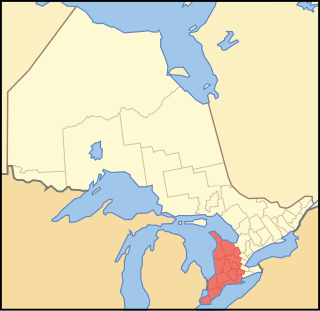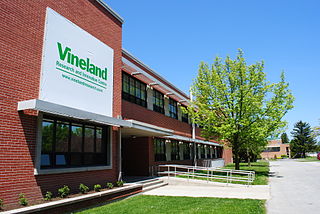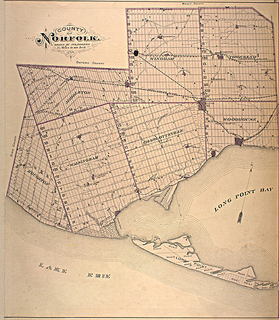Related Research Articles

Port Dover is an unincorporated community and former town located in Norfolk County, Ontario, Canada, on the north shore of Lake Erie. It is the site of the recurring Friday the 13th motorcycle rally. Prior to the War of 1812, this community was known as Dover Mills.

Southwestern Ontario is a secondary region of Southern Ontario in the Canadian province of Ontario. It occupies most of the Ontario Peninsula bounded by Lake Huron, including Georgian Bay, to the north and northwest; the St. Clair River, Lake St. Clair, and Detroit River, to the west; and Lake Erie to the south. To the east, on land, Southwestern Ontario is bounded by Central Ontario and the Golden Horseshoe. The region had a population of 2,583,544 in 2016. It is sometimes further divided into "Midwestern Ontario" covering the eastern half of the area and the heart of Southwestern Ontario encompassing the western half of the region.

Vineland is an unincorporated community within the Town of Lincoln in Niagara Region. Located in the Canadian province of Ontario, it is bordered by the Twenty Mile Creek and Jordan to the east, Lake Ontario to the north, Beamsville to the west, and Pelham to the south. Vineland is primarily an agricultural community, and is home to many tender fruit farms and wineries. As the second-largest community in the Town of Lincoln, Vineland's small commercial centre along King Street serves the surrounding communities of Campden and Jordan. Post office established in 1894.
Pine Grove is a hamlet in Norfolk County, Ontario, Canada, near Delhi. The surrounding terrain of the village is mostly wooded. Pine Grove is very centralized to towns and communities that have necessary services for Pine Grove residents.
The Ontario tobacco belt is the tobacco-growing region located in Norfolk County and eastern Elgin County in Southwestern Ontario, Canada. The region is close to the north shore of Lake Erie, with a moderate climate and sandy, silt-loam soils that are well-suited to a wide variety of crops.

Port Rowan is a town in Norfolk County, Ontario, Canada. It is located on Lake Erie, adjacent to Long Point. The lakeside community has a population of fewer than 1500 people and sports a number of traditional small businesses such as Twin's Ice Cream Parlour, which has been operating in the town for decades.
Langton is a small town located in Norfolk County; formerly known as Boughner's Corner.

Walsh is a medium-sized hamlet in Norfolk County, Ontario, Canada.

Nixon is a village in Norfolk County, Ontario, Canada that is almost exclusively residential. This community is east of the town of Delhi, northwest of the town of Simcoe, southwest of the town of Waterford, and northeast of the hamlet of Pinegrove.
Port Ryerse is a fishing hamlet in Norfolk County, Ontario, Canada, southwest of Port Dover. The hamlet is popular with persons from Southwestern Ontario who rent cottages and fish for pleasure during the summer months.
Nanticoke is an unincorporated community and former city located on the western border of Haldimand County, Ontario, Canada. Nanticoke is located directly across Lake Erie from the US city of Erie, Pennsylvania.
Lynedoch is a village in Norfolk County, Ontario, Canada and was named after Baron Lynedoch who served under Lord Wellington during the War of 1812.
Clear Creek is a hamlet in southwestern Norfolk County, Ontario, Canada.

Extratropical cyclones, sometimes called mid-latitude cyclones or wave cyclones, are low-pressure areas which, along with the anticyclones of high-pressure areas, drive the weather over much of the Earth. Extratropical cyclones are capable of producing anything from cloudiness and mild showers to heavy gales, thunderstorms, blizzards, and tornadoes. These types of cyclones are defined as large scale (synoptic) low pressure weather systems that occur in the middle latitudes of the Earth. In contrast with tropical cyclones, extratropical cyclones produce rapid changes in temperature and dew point along broad lines, called weather fronts, about the center of the cyclone.
Blayney is a hamlet in Norfolk County, Ontario, Canada that is in between Pine Grove and Green's Corners.

Hillcrest is a hamlet in Norfolk County, Ontario, Canada that is in between Bill's Corners and the town of Simcoe.

The climate of New York state is generally humid continental, while the extreme southeastern portion of the state lies in the warmer humid subtropical climate zone. Winter temperatures average below freezing during January and February in much of New York state, but several degrees above freezing along the Atlantic coastline, including New York City.

Norfolk County in the Canadian province of Ontario consists of a long list of communities. Its four designated population centres are Simcoe, Port Dover, Delhi, and Waterford.
Glen Meyer is an unincorporated community in Norfolk County, Ontario, Canada, southeast of Tillsonburg.
This is a timeline of the history of Port Dover, Ontario, Canada.
References
- ↑ Basic information at Rural Routes
- ↑ Frogmore Wind Project Archived 2010-12-23 at the Wayback Machine at Canadian Wind Energy Association
- ↑ "Norfolk Seeks End to Turbine Development" . Retrieved 2013-05-15.
- ↑ Assel, Raymond A. (1980). "Maximum Freezing Degree-Days as a Winter Severity Index for the Great Lakes, 1897–1977". Monthly Weather Review. American Meteorological Society. 108 (9): 1440. Bibcode:1980MWRv..108.1440A. doi: 10.1175/1520-0493(1980)108<1440:MFDDAA>2.0.CO;2 . ISSN 1520-0493.